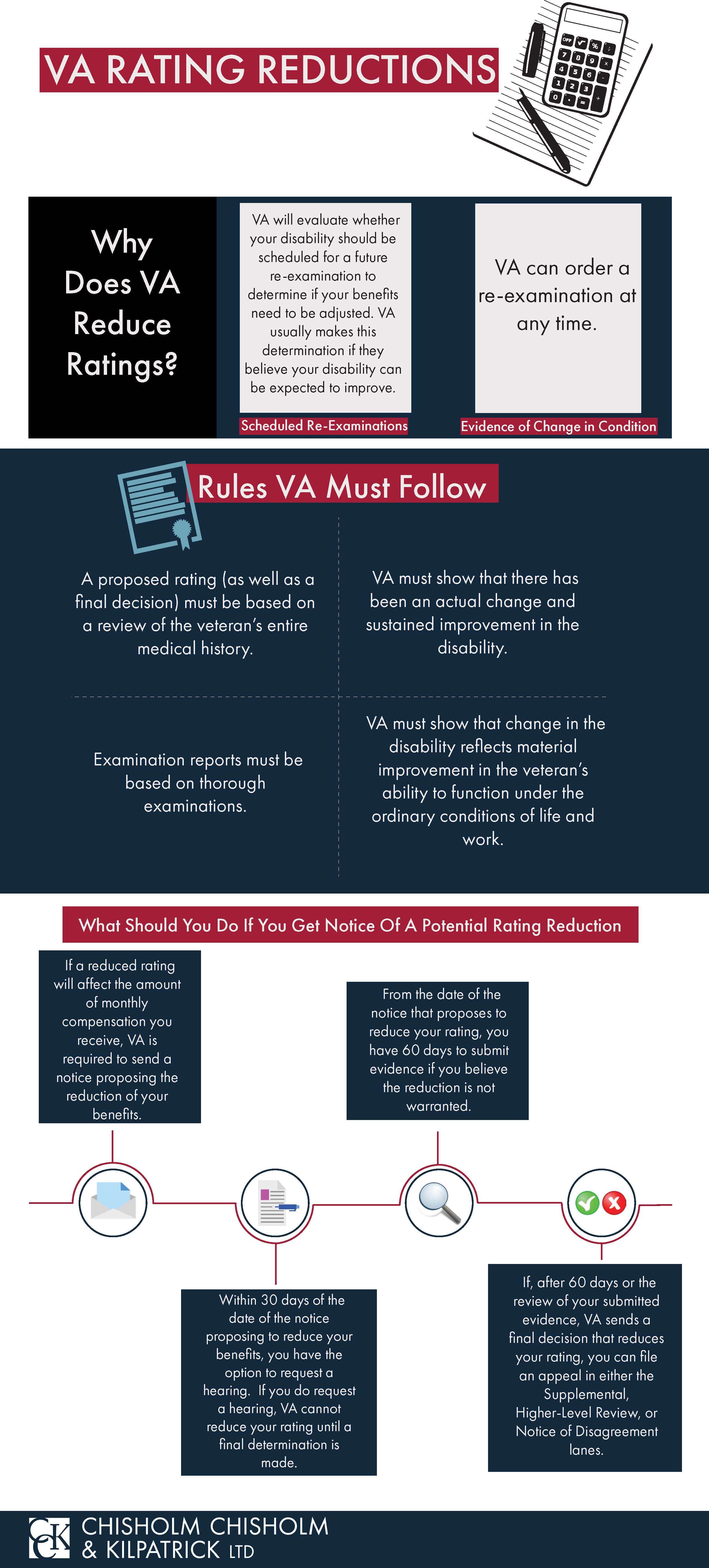Rating Reductions: What VA Can and Cannot Do

Under certain conditions, VA may reduce your disability rating. Legally, VA is entitled to rating reductions but there are rules they must follow when doing so. But unfortunately, mistakes are still made and VA often does not get rating reductions quite right. So, in this post, we’ll discuss what VA can and cannot do when reducing your rating and what you should do if VA sends notice that your rating may be adjusted.

Why does VA reduce ratings?
The idea is that some service-connected conditions will improve over time or with treatment and VA wants to make sure they are compensating each veteran according to their present level of disability. For example, if you had service-connected cancer and but it goes into remission, VA would propose a rating reduction because, presumably, your cancer is less disabling – i.e. has less of an impact on your ability to function in life and at work.
VA normally starts the process of reducing a rating under two circumstances:
- Scheduled re-examinations. Usually, VA will evaluate (after you are granted service-connection) whether your disability should be scheduled for a future re-examination (a C&P exam) to determine if your benefits need to be adjusted. VA usually makes this determination if they believe your disability can be expected to improve. Typically, the first re-exam will be scheduled 2-5 years from the date of your first Rating Decision.
- Evidence of change in condition. VA can also order a re-examination at any time if there is new, relevant medical evidence that your disability has improved.
But disabilities, as you likely know, are complicated. Symptoms of a disability may temporarily decrease but resume at baseline level soon after. Or, for example, symptoms may improve but not enough to significantly (or, as VA would say, materially) improve your ability to function under the ordinary stressors of life or work. So VA has strict rules guiding the process of rating reductions. But, those guidelines are not always applied correctly, so it can help to have an idea of what VA is required to do.
General Rules VA Must Follow for Rating Reductions
There are a number of things VA must do when reducing ratings under any circumstances:
- A proposed rating (as well as a final decision) must be based on a review of the veteran’s entire medical history
- VA must show that there has been an actual change in the disability since the last rating decision
- VA must show that change in the disability reflects material improvement in the veteran’s ability to function under the ordinary conditions and stressors of life and work
- Examination reports must be based on thorough examinations
Additionally, the procedural manual (M21) that VA adjudicators use to process claims states that VA must outline the time period during which your condition is said to have (materially) improved.
What to do if you get notice of a potential rating reduction
VA is required to send a letter proposing the reduction of your benefits, if the decrease will affect the amount of monthly compensation you receive. The letter is not a final VA decision and so cannot be appealed, but VA gives you the opportunity to respond to the proposal by submitting evidence and/or attending a hearing.
From the date of the letter, you have 60 days to submit evidence if you believe the reduction is not warranted. Within the first 30 days of the 60-day period, you have the option to request a hearing to be conducted by VA personnel unrelated to the proposed reduction. VA must consider evidence you submit during this period (including the transcript of the hearing, if you choose to attend one) and all previous evidence and medical records associated with your file.
What are some types of evidence you might submit? You do not need to submit treatment records from your VA Medical Center as VA already has access to those documents. But it can be helpful to submit a medical opinion from an outside, independent doctor if your Compensation and Pension exam was not favorable. Additionally, you may want to submit statements from family, friends, or employers who have observed your ability to function in daily life and/or at work. If you choose not to submit evidence within the 60-day period, VA will issue a final decision reducing your rating.
If, after 60 days or the review of your submitted evidence, VA sends a final decision that reduces your rating, you can file an appeal with a Notice of Disagreement form.
Special Cases: Protected from Rating Reduction
For certain special cases, there are rules in place that protect veterans from rating reductions or severance of their disability benefits.
Stabilized Ratings: 5 Years or more
Any rating that has remained at the same level for 5 years or longer is considered “stabilized.” In addition to the general rating reduction rules that VA must follow (see above), VA must show sustained improvement in your condition.
What does sustained improvement mean? Essentially it means one of two things: Either 1) VA cannot use just one re-examination (C&P exam) to show ‘sustained’ improvement, rather they must show through medical records as well as a C&P re-exam that you are not just temporarily experiencing improvement. Or, 2) VA must show that the evidence in your file predominantly demonstrates ‘sustained.’
VA must provide an explanation of why they are reasonably certain your condition will continue to show ‘sustained’ improvement.
100% (Total) Ratings
VA can reduce a total rating (that is, a rating of 100%) only if there is material improvement in the veteran’s condition. In addition to the general rating reduction rules, VA must provide evidence that your condition has improved such that there has been an observable change in your ability to function under the conditions of daily life.
Continuous Ratings: 20 years or more
Conditions that have been rated at or above a certain rating level for 20 years or longer are considered “continuous.” VA cannot reduce a continuous rating below the original rating level (unless they determine the rating was based on fraud). For example, if a veteran’s service-connected PTSD was originally rated 30% disabling and fluctuated between 30% and 70% over the next 20 years (without dipping below 30%), VA could not reduce the rating to below 30 percent.
Contact Chisholm Chisholm & Kilpatrick Today for a free case evaluation.
If your VA disability rating has been improperly reduced, our team of experienced attorneys may be able to help you. Contact our office today for a free case evaluation at (800) 544-9144.
About the Author
Share this Post

